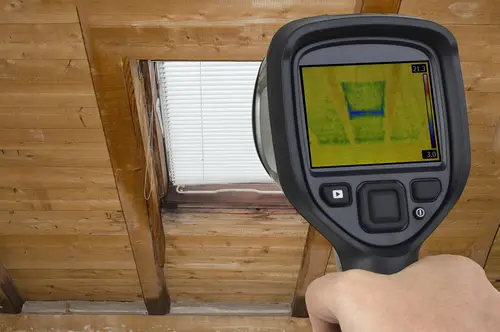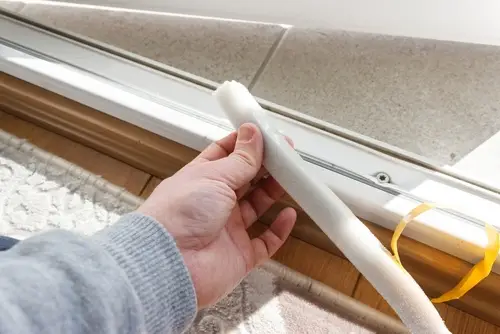Mr. Handyman® experts explain how replacing or sealing an attic door can prevent air leaks between your living space and attic.
|
Your attic door might seem like a minor detail, but it has a major impact on your home’s comfort and efficiency. Sealing or replacing a drafty attic door is a smart upgrade that can improve your home’s insulation and save you money.
Let’s take a closer look at how much energy your attic door may be costing you, and what you can do about it—from quick fixes to professional attic door installation.
Why Your Attic Door Is a Hidden Energy Leak (and What It Costs You)
Because the attic door isn’t something you use every day, many homeowners don’t realize how much energy they’re losing until the bills start creeping up.
Think of a degraded or drafty attic door like a window left cracked open … all year long. You may not notice it, but the loss of efficiency adds up fast. In fact, research shows an unsealed attic hatch can slash insulation efficiency by nearly 27%.
In winter, that small gap allows warm air to drift upward and disappear into unused attic space. In summer, attic temperatures can reach 120–140°F, and all that heat pushes back down into your living space.
The result? A house that never feels fully comfortable and an HVAC system that has to work overtime.
How a Sealed Attic Door Saves Money Year-Round
A properly sealed attic door works like a lid on a pot—it keeps the temperature where it belongs.
According to the Environmental Protection Agency (EPA), combining attic door sealing with proper insulation can save the average homeowner up to 15% on heating and cooling costs.
Pairing a sealed attic hatch with professional attic insulation services can maximize heating and cooling efficiency throughout your home. That doesn’t just mean lower energy bills, but also fewer drafts, less wear on your HVAC system, and a home that finally feels comfortable in every room.

Signs It’s Time to Seal or Replace Your Attic Door
Not sure if your attic door is to blame for drafts or high bills? A few telltale clues usually give it away:
- You feel a breeze every time you walk under the attic hatch, even when the door is closed.
- There are visible gaps around the frame.
- Your utility bills keep creeping up, but nothing else in the house has changed.
- The hatch sticks or sags, making it hard to open or close.
- Weatherstripping appears cracked or flattened, or is missing entirely.
These small issues add up fast. If your attic door checks more than one of these boxes, it’s likely costing you money every month. Addressing the problem before the next heat wave or cold snap with attic door replacement or sealing is a simple upgrade with big payoffs.
Pro Tip: Ready to address every energy leak in your home? Check out our home energy efficiency checklist.
DIY Energy-Saving Tips Before Attic Door Replacement

Not ready to schedule a full attic door installation yet? Here are a few quick fixes that can reduce drafts and energy loss right away:
Seal with weatherstripping
Self-adhesive foam strips can block small gaps around your attic hatch. This cost-effective upgrade can make the area feel less drafty and help save on heating and cooling costs.
Add an attic stair cover or insulation tent
Lightweight covers fit over pull-down ladders or scuttle holes. According to the Department of Energy, insulating attic doors and hatches is one of the easiest ways to cut household energy waste.
Check insulation quality
If the insulation around your attic hatch looks thin or flattened, adding more can improve efficiency. Even a small layer can reduce heat transfer between rooms.
Use a temporary draft blocker
A rolled towel or draft snake at the base of the hatch can make a noticeable difference during extreme temperatures.
These handy tricks are simple and low-cost, but they’re not permanent. Let’s look at how you can spot signs of air loss with a few simple DIY checks—and why professional attic door installation or replacement is the lasting fix.
DIY Checks vs. Professional Attic Door Installation
Think your attic door might be leaking air? Here are a few quick DIY tests you can try before calling in help:
- Feel for a draft: Run your hand around the hatch on a hot or cold day. If you feel air moving, it’s escaping.
- Shine a light: If a light in the attic seeps around the edges of the hatch, so will heated or cooled air.
- Track room comfort: Do bedrooms near the attic always feel too hot in the summer or too chilly in the winter? That’s probably a sign of a leaky hatch.
Want more ways to test for drafts? The U.S. Department of Energy offers a helpful guide on how to detect air leaks in your home.
These checks provide clues, but they won’t fix the problem. Effective attic door repair and replacement takes precision and the right materials.
A home improvement professional can install insulated attic doors with high-R value boards and weatherstripping for maximum efficiency, ensuring your attic hatch is tightly sealed for long-term energy savings.
Professional Attic Door Installation with Mr. Handyman
Fixing an attic door isn’t just about swapping hardware—it’s about sealing your home’s energy envelope with expert attic door installation. At Mr. Handyman®, our service professionals follow a proven process to make sure your new attic door does its job:
- We carefully measure your attic hatch opening to ensure a perfect fit.
- We install and secure a durable, insulated door designed to stop leaks.
- We add high-R attic door insulation and weatherstripping for maximum efficiency.
- We seal and test the door to confirm it’s draft-free.
The result? Lower bills, reliable indoor comfort, reduced wear on your HVAC system, and even an improved resale value for your home.
Sealing and insulating attic doors is just one way to improve your home’s overall efficiency. For more proven ways to boost performance, explore attic insulation tips from ENERGY STAR.
Ready to Save? Schedule Your Attic Door Replacement Today
Your attic door shouldn’t be the weak link in your home’s efficiency. If drafts, uneven room temperatures, or high energy bills sound familiar, it’s time to take action. Sealing or replacing an attic hatch is a simple upgrade with lasting benefits, including lower bills, fewer drafts, and consistent comfort year-round.
Mr. Handyman makes it simple. Our experienced professionals provide high-quality attic door installation and replacement services near you. One call gets it done—promptly, efficiently, and backed by our Neighborly Done Right Promise®. Contact your local Mr. Handyman today.
This article is intended for general informational purposes only and may not be applicable to every situation. You are responsible for determining the proper course of action for your home and property. Mr. Handyman is not responsible for any damages that occur as a result of this blog content or your actions. For the most accurate guidance, contact your local Mr. Handyman location for a comprehensive, on-site assessment.
FAQs About Attic Doors and Energy Savings
For over 25 years, Mr. Handyman professionals have been helping homeowners and businesses repair, maintain, and enhance their spaces. We are a one-stop solution for everything on your to-do list. This includes answering your questions about home repairs, maintenance, and improvements. Here are answers to some of your most frequently asked questions about attic door replacement and sealing.
Can sealing or replacing an attic door lower my energy bills?
Yes! Sealing or replacing an attic door is one of the easiest and most effective ways to save energy.
According to ENERGY STAR, properly insulating and sealing attic doors can cut heating and cooling costs by up to 15%. An insulated attic door keeps conditioned air inside, reduces HVAC strain, and helps lower monthly utility bills.
What is the best way to insulate an attic hatch for energy savings?
One of the most effective methods of enhancing attic door insulation is adding a rigid foam cover box with weatherstripping. This technique creates a tight seal around the attic hatch, reducing drafts and improving the R-value of your insulation.
Even this simple attic door insulation upgrade can help stop air leaks and increase your home's efficiency.
Why is an unsealed attic door especially costly in summer?
An attic can reach 120–140°F during the summer months. If your attic door isn’t insulated, that heat radiates into living spaces, forcing your AC to work harder.
A properly sealed attic door blocks hot attic air, lowers cooling costs, and keeps your home more comfortable in every season.
Can attic door gaps really reduce overall insulation effectiveness?
Yes. Even a 1% gap around an attic hatch can reduce the effectiveness of attic insulation by as much as 25–27%.
An attic door with poor sealing lets conditioned air escape, wasting energy and making your entire insulation system less effective. Professional attic door sealing helps ensure your insulation works as designed.
Does insulating just the attic door help, or does the whole attic need work?
Attic door insulation is a great first step for improving efficiency, but pairing it with complete attic insulation can increase energy savings by 10–20% more. Together, attic door insulation and full attic sealing prevent air leaks, reduce drafts, and maximize your return on investment.
Are there rebates or incentives for attic door insulation or replacement?
Many energy programs offer rebates and tax credits for home air sealing and attic insulation upgrades. Check your local energy provider’s website for information on available rebate programs.
Additionally, improving your attic door with professional attic door replacement or insulation services can qualify under ENERGY STAR efficiency incentives, helping offset costs while boosting your long-term energy savings.
